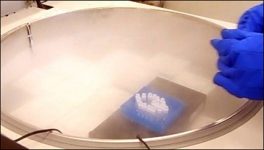
Cryogatt launches low-temperature sample RFID tracking solution for application testing at NIBSC
[ad_1]
Cryogatt Systems is launching an RFID tracking solution for cryopreserved specimens, which uses HID Global’s Piccolino passive 13.56MHz high frequencyRFIDTag, Cryogatt reader and software platform, and use HID’s Vigo direct attachment technology to attach tag antenna and chip. These readers and tags can be used at minus 196 degrees. Currently, several laboratories that need to store human case samples, blood and tissues are using this solution.
These companies started testing with the National Institute of Biological Standards and Control (NIBSC) two years ago. NIBSC is a British biopharmaceuticals, related standards and materials development agency.

Cryogatt president Philippa Kennedy said: “The industry is facing some challenges in ensuring that stem cells are stored at the specified temperature.” The operating temperature of these refrigerated cabinets is generally between minus 80 degrees and minus 196 degrees. In addition, medical specimen management organizations also need to follow national regulations and procedures.
Usually, cryogenic samples are stored in glass bottles, plastic bottles or test tubes. Most companies use handwritten or printed labels for identification. Recently, more and more companies have begun to use QR code labels. When the sample is stored in an extremely low temperature environment, the storage container will be frosted, which also makes it difficult to read the QR code label. The label is also easy to fall off. Kennedy explained: “It is very important to protect samples from damage caused by temperature rise during storage.” In addition, employees also need to quickly locate and find specific test tubes, which may also cause abnormalities.
In order to prevent errors and meet requirements, the laboratory needs to conduct regular inspections. However, sample inspection is very time-consuming and usually requires two employees to perform it. Each refrigerator can store hundreds of sample racks with 100 test tubes. Employees need to identify each test tube by looking at the label, and the average error rate in this process is as high as 9%. Kennedy said: “These errors may bring legal risks.”
Kennedy said that if the hardware can run well at low temperatures, RFID is a better choice. So far, there is no RFID solution on the market that runs in such an environment. At the beginning of development, Cryogatt purchased hundreds of Piccolino tags from the representative office of HID Global in the United Kingdom and tested them in a low temperature environment. The company found that the label is being used well. Then, the company began contacting HID Global to customize small-size labels that can withstand low temperatures.
At the same time, Cryogatt also began to design a reader and a software platform for tracking cryogenic specimens.

In January 2014, HID Global launched Vigo attachment technology, allowing small tags with chips and antennas to be manufactured without additional soldering materials. Richard Aufreiter, product manager of HID Global, said that Piccolino tags comply with the ISO15693 standard. These tags are available in three sizes of 6.5, 7.5 and 9.5 mm, with a thickness of 1 mm.
In the morning of 2013, NIBSC purchased a complete Cryogatt “Inventory Control and Inspection System”. In June of the same year, the agency launched the reliability test of the system, and regularly tested tags and tagged systems in an environment of minus 196 degrees Celsius.
The NIBSC solution tested this time has an embedded Vigo Piccolino label attached to each test tube and storage tray. Experimenters will also use Cryogatt readers to read these tags to identify, locate and inspect samples in the storage cabinet.
NIBSC’s genetic standard sample department hopes to reduce labor and error probability through the sample tracking system.
In this pilot project, Cryogatt attached a label to the NIBSC test tube and entered the test tube label ID number in the Cryogatt software. The ID number was bound to the sample deposit number, patient name and brief history.
A Cryogatt reader with integrated antenna is installed in the sample preparation area. In addition, a similar reader is installed at the entrance and exit of the refrigerated cabinet room.
Kennedy said: “The results of the pilot show that the system is reliable. In the past two years, the system has a zero error rate.”
In August 2014, a freezer in the Royal Bristol Hospital used the Cryogatt-HID solution. Kennedy said: “We are also negotiating with 43 hospitals in the UK at the same time. This market is huge.”
[ad_2]



